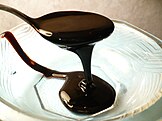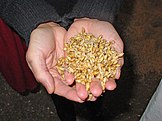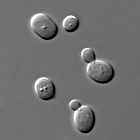|
These are the articles that are featured on the Drink Portal main page. If you wish to add an article, you will be expected to make a good-faith effort to address objections that are raised. Consensus must be reached for an article to be promoted to be given selected article status. When adding a qualifying article, it is preferred for it to be classified as a Good article or better. These articles can be found in the Category:A-Class Food and drink articles, Category:FA-Class Food and drink articles and Category:GA-Class Food and drink articles categories. Please note that you cannot determine the status of an article that you have worked on. Please follow the usage instructions listed below when placing a new article here, |
Selected content:
Selected content tools: |
UsageThe template for used to configure these sub-pages is located at {{Selected ingredient}}
| |
Purge server cache
Selected ingredient 1
Portal:Drink/Selected ingredient/1
Hops are the flowers (also called seed cones or strobiles) of the hop plant Humulus lupulus, a member of the Cannabaceae family of flowering plants. They are used primarily as a bittering, flavouring, and stability agent in beer, to which, in addition to bitterness, they impart floral, fruity, or citrus flavours and aromas. Hops are also used for various purposes in other beverages and herbal medicine. The hops plants have separate female and male plants, and only female plants are used for commercial production. The hop plant is a vigorous, climbing, herbaceous perennial, usually trained to grow up strings in a field called a hopfield, hop garden (in the South of England), or hop yard (in the West Country and United States) when grown commercially. Many different varieties of hops are grown by farmers around the world, with different types used for particular styles of beer.The first documented use of hops in beer is from the 9th century, though Hildegard of Bingen, 300 years later, is often cited as the earliest documented source. Before this period, brewers used a "gruit", composed of a wide variety of bitter herbs and flowers, including dandelion, burdock root, marigold, horehound (the old German name for horehound, Berghopfen, means "mountain hops"), ground ivy, and heather. Early documents include mention of a hop garden in the will of Charlemagne's father, Pepin the Short.
Hops are also used in brewing for their antibacterial effect over less desirable microorganisms and for purported benefits including balancing the sweetness of the malt with bitterness and a variety of flavours and aromas. It is believed that traditional herb combinations for beers were abandoned after it was noticed that beers made with hops were less prone to spoilage.Selected ingredient 2
Portal:Drink/Selected ingredient/2

Selected ingredient 3
Portal:Drink/Selected ingredient/3
Caffeine is a central nervous system (CNS) stimulant of the methylxanthine class. It is mainly used as a eugeroic (wakefulness promoter) or as a mild cognitive enhancer to increase alertness and attentional performance. Caffeine acts by blocking binding of adenosine to the adenosine A1 receptor, which enhances release of the neurotransmitter acetylcholine. Caffeine has a three-dimensional structure similar to that of adenosine, which allows it to bind and block its receptors. Caffeine also increases cyclic AMP levels through nonselective inhibition of phosphodiesterase.
Caffeine is a bitter, white crystalline purine, a methylxanthine alkaloid, and is chemically related to the adenine and guanine bases of deoxyribonucleic acid (DNA) and ribonucleic acid (RNA). It is found in the seeds, fruits, nuts, or leaves of a number of plants native to Africa, East Asia and South America, and helps to protect them against herbivores and from competition by preventing the germination of nearby seeds, as well as encouraging consumption by select animals such as honey bees. The best-known source of caffeine is the coffee bean, the seed of the Coffea plant. People may drink beverages containing caffeine to relieve or prevent drowsiness and to improve cognitive performance. To make these drinks, caffeine is extracted by steeping the plant product in water, a process called infusion. Caffeine-containing drinks, such as coffee, tea, and cola, are consumed globally in high volumes. In 2020, almost 10 million tonnes of coffee beans were consumed globally. Caffeine is the world's most widely consumed psychoactive drug. Unlike most other psychoactive substances, caffeine remains largely unregulated and legal in nearly all parts of the world. Caffeine is also an outlier as its use is seen as socially acceptable in most cultures and even encouraged in others. (Full article...)
Selected ingredient 4
Portal:Drink/Selected ingredient/4
Molasses (/məˈlæsɪz, moʊ-/) is a viscous byproduct, principally obtained from the refining of sugarcane or sugar beet juice into sugar. Molasses varies in the amount of sugar, the method of extraction and age of the plant. Sugarcane molasses is usually used to sweeten and flavour foods. Molasses is a major constituent of fine commercial brown sugar.Molasses is rich in vitamins and minerals, including vitamin B6, iron, calcium, magnesium, and potassium. There are different types of molasses, including first molasses (highest sugar content), second molasses (slightly bitter), and blackstrap molasses (the darkest and most robust in flavor). Molasses was historically popular in the Americas before the 20th century as a sweetener. It is still commonly used in traditional cuisine, such as in Madeira Island's traditional dishes.
In addition to culinary uses, molasses has industrial applications, such as in the distillation of rum, additive in mortar, and as a soil amendment to promote microbial activity. The unique flavor and nutritional profile of molasses make it a versatile ingredient with both food and non-food applications.Selected ingredient 5
Portal:Drink/Selected ingredient/5
The kola nut (Igbo: ọjị, Sängö: gôro, Dagbani: guli, Swahili: mukezu) is the seed of certain species of plant of the genus Cola, placed formerly in the cocoa family Sterculiaceae and now usually subsumed in the mallow family Malvaceae (as subfamily Sterculioideae). These cola species are trees native to the tropical rainforests of Africa. Their caffeine-containing seeds are about 5 centimetres (2.0 in) across and are used as flavoring ingredients in various carbonated soft drinks, from which the name cola originates.Selected ingredient 6
Portal:Drink/Selected ingredient/6
Malting is a process applied to cereal grains, in which the grains are made to germinate by soaking in water and are then quickly halted from germinating further by drying/heating with hot air. Malting is thus a combination of two processes; namely the sprouting process and the kiln-drying process. These latter terms are often preferred when referring to the field of brewing for batches of beer or other beverages as they provide more in-depth information. Malted grain is used to make malt beer, malt whisky, malted shakes, malt vinegar, and some baked goods, such as bagels. Malting grains develops the enzymes that are required to modify the grain's starches into sugars, including monosaccharides (glucose, fructose, etc.) and disaccharides (sucrose, etc.). It also develops other enzymes, such as proteases which break down the proteins in the grain into forms which can be utilized by yeast. Barley is the most commonly malted grain in part because of its high diastatic power or enzyme content. Also very important is the retention of the grain's husk even after threshing, unlike the bare seeds of threshed wheat or rye. This protects the growing acrospire (developing plant embryo) from damage during malting, which can easily lead to mold growth. It also allows the mash of converted grain to create a filter bed during lautering (see brewing). Other grains may be malted, especially wheat.
Selected ingredient 7
Portal:Drink/Selected ingredient/7
Yeasts are eukaryotic, single-celled microorganisms classified as members of the fungus kingdom. The first yeast originated hundreds of millions of years ago, and at least 1,500 species are currently recognized. They are estimated to constitute 1% of all described fungal species.Some yeast species have the ability to develop multicellular characteristics by forming strings of connected budding cells known as pseudohyphae or false hyphae, or quickly evolve into a multicellular cluster with specialised cell organelles function. Yeast sizes vary greatly, depending on species and environment, typically measuring 3–4 µm in diameter, although some yeasts can grow to 40 µm in size. Most yeasts reproduce asexually by mitosis, and many do so by the asymmetric division process known as budding. With their single-celled growth habit, yeasts can be contrasted with molds, which grow hyphae. Fungal species that can take both forms (depending on temperature or other conditions) are called dimorphic fungi.
The yeast species Saccharomyces cerevisiae converts carbohydrates to carbon dioxide and alcohols through the process of fermentation. The products of this reaction have been used in baking and the production of alcoholic beverages for thousands of years. S. cerevisiae is also an important model organism in modern cell biology research, and is one of the most thoroughly studied eukaryotic microorganisms. Researchers have cultured it in order to understand the biology of the eukaryotic cell and ultimately human biology in great detail. Other species of yeasts, such as Candida albicans, are opportunistic pathogens and can cause infections in humans. Yeasts have recently been used to generate electricity in microbial fuel cells and to produce ethanol for the biofuel industry. (Full article...)Selected ingredient 8
Portal:Drink/Selected ingredient/8
Rice is a cereal grain, and in its domesticated form is the staple food for over half of the world's human population, particularly in Asia and Africa, due to the vast amount of soil that is able to grow rice. Rice is the seed of the grass species Oryza sativa (Asian rice) or, much less commonly, O. glaberrima (African rice). Asian rice was domesticated in China some 13,500 to 8,200 years ago, while African rice was domesticated in Africa some 3,000 years ago. Rice has become commonplace in many cultures worldwide; in 2021, 787 million tons were produced, placing it fourth after sugarcane, maize, and wheat. Only some 8% of rice is traded internationally. China, India, and Indonesia are the largest consumers of rice. A substantial amount of the rice produced in developing nations is lost after harvest through factors such as poor transport and storage. Rice yields can be reduced by pests including insects, rodents, and birds, as well as by weeds, and by diseases such as rice blast. Traditional polycultures such as rice-duck farming, and modern integrated pest management seek to control damage from pests in a sustainable way.Many varieties of rice have been bred to improve crop quality and productivity. Biotechnology has created Green Revolution rice able to produce high yields when supplied with nitrogen fertilizer and managed intensively. Other products are rice able to express human proteins for medicinal use; flood-tolerant or deepwater rice; and drought-tolerant and salt-tolerant varieties. Rice is used as a model organism in biology.
Dry rice grain is milled to remove the outer layers; depending on how much is removed, products range from brown rice to rice with germ and white rice. Some is parboiled to make it easy to cook. Rice contains no gluten; it provides protein but not all the essential amino acids needed for good health. Rice of different types is eaten around the world. Long-grain rice tends to stay intact on cooking; medium-grain rice is stickier, and is used for sweet dishes, and in Italy for risotto; and sticky short-grain rice is used in Japanese sushi as it keeps its shape when cooked. White rice when cooked contains 29% carbohydrate and 2% protein, with some manganese. Golden rice is a variety produced by genetic engineering to contain vitamin A. (Full article...)Selected ingredient 9
Portal:Drink/Selected ingredient/9
Quinine is a medication used to treat malaria and babesiosis. This includes the treatment of malaria due to Plasmodium falciparum that is resistant to chloroquine when artesunate is not available. While sometimes used for nocturnal leg cramps, quinine is not recommended for this purpose due to the risk of serious side effects. It can be taken by mouth or intravenously. Malaria resistance to quinine occurs in certain areas of the world. Quinine is also used as an ingredient in tonic water to impart a bitter taste.
Common side effects include headache, ringing in the ears, vision issues, and sweating. More severe side effects include deafness, low blood platelets, and an irregular heartbeat. Use can make one more prone to sunburn. While it is unclear if use during pregnancy carries potential for fetal harm, treating malaria during pregnancy with quinine when appropriate is still recommended. Quinine is an alkaloid, a naturally occurring chemical compound. How it works as a medicine is not entirely clear.
Quinine was first isolated in 1820 from the bark of a cinchona tree, which is native to Peru, and its molecular formula was determined by Adolph Strecker in 1854. The class of chemical compounds to which it belongs is thus called the cinchona alkaloids. Bark extracts had been used to treat malaria since at least 1632 and it was introduced to Spain as early as 1636 by Jesuit missionaries returning from the New World. It is on the World Health Organization's List of Essential Medicines. Treatment of malaria with quinine marks the first known use of a chemical compound to treat an infectious disease. (Full article...)
Selected ingredient 10
Portal:Drink/Selected ingredient/10
Agave (/əˈɡɑːvi/; also UK: /əˈɡeɪvi/; Anglo-Hispanic, also US: /əˈɡɑːveɪ/) is a genus of monocots native to the arid regions of the Americas. The genus is primarily known for its succulent and xerophytic species that typically form large rosettes of strong, fleshy leaves. Agave now includes species formerly placed in a number of other genera, such as Manfreda, ×Mangave, Polianthes and Prochnyanthes.Many plants in this genus may be considered perennial, because they require several to many years to mature and flower.[page needed] However, most Agave species are more accurately described as monocarpic rosettes or multiannuals, since each individual rosette flowers only once and then dies; a small number of Agave species are polycarpic.[page needed]
Along with plants from the closely related genera Yucca, Hesperoyucca, and Hesperaloe, various Agave species are popular ornamental plants in hot, dry climates, as they require very little supplemental water to survive. Most Agave species grow very slowly. Some Agave species are known by the common name "century plant".
Maguey is a Spanish word that refers to all of the large-leafed plants in the Asparagaceae family, including agaves and yuccas. Maguey flowers are eaten in many indigenous culinary traditions of Mesoamerica. (Full article...)
Selected ingredient 11
Portal:Drink/Selected ingredient/11
Aspartame is an artificial non-saccharide sweetener 200 times sweeter than sucrose and is commonly used as a sugar substitute in foods and beverages. It is a methyl ester of the aspartic acid/phenylalanine dipeptide with brand names NutraSweet, Equal, and Canderel. Aspartame was approved by the US Food and Drug Administration (FDA) in 1974, and then again in 1981, after approval was revoked in 1980.
Selected ingredient 12
Portal:Drink/Selected ingredient/12 High-fructose corn syrup (HFCS), also known as glucose–fructose, isoglucose and glucose–fructose syrup, is a sweetener made from corn starch. As in the production of conventional corn syrup, the starch is broken down into glucose by enzymes. To make HFCS, the corn syrup is further processed by D-xylose isomerase to convert some of its glucose into fructose. HFCS was first marketed in the early 1970s by the Clinton Corn Processing Company, together with the Japanese Agency of Industrial Science and Technology, where the enzyme was discovered in 1965.
As a sweetener, HFCS is often compared to granulated sugar, but manufacturing advantages of HFCS over sugar include that it is cheaper. "HFCS 42" and "HFCS 55" refer to dry weight fructose compositions of 42% and 55% respectively, the rest being glucose. HFCS 42 is mainly used for processed foods and breakfast cereals, whereas HFCS 55 is used mostly for production of soft drinks.
The United States Food and Drug Administration (FDA) states that it is not aware of evidence showing that HFCS is less safe than traditional sweeteners such as sucrose and honey. Uses and exports of HFCS from American producers have grown steadily during the early 21st century.Selected ingredient 13
Portal:Drink/Selected ingredient/13
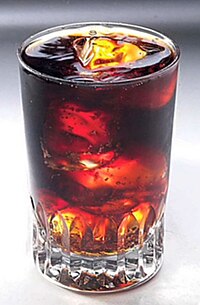
Caramel color or caramel coloring is a water-soluble food coloring. It is made by heat treatment of carbohydrates (sugars), in general in the presence of acids, alkalis, or salts, in a process called caramelization. It is more fully oxidized than caramel candy, and has an odor of burnt sugar and a somewhat bitter taste. Its color ranges from pale yellow to amber to dark brown.
Caramel color is one of the oldest and most used food colorings for enhancing naturally occurring colors, correcting natural variations in color, and replacing color that is lost to light degradation during food processing and storage. The use of caramel color as a food additive in the brewing industry in the 19th century is the first recorded instance of it being manufactured and used on a wide scale. Today, caramel color is found in many commercially made foods and beverages, including batters, beer, brown bread, buns, chocolate, cookies, cough drops, spirits and liquor such as brandy, rum, and whisky, chocolate-flavored confectionery and coatings, custards, decorations, fillings and toppings, potato chips, dessert mixes, doughnuts, fish and shellfish spreads, frozen desserts, fruit preserves, glucose tablets, gravy, ice cream, pickles, sauces and dressings, soft drinks (especially colas), sweets, vinegar, and more. Caramel color is widely approved for use in food globally but application and use level restrictions vary by country. (Full article...)
Selected ingredient 14
Portal:Drink/Selected ingredient/14

Potassium benzoate (E212), the potassium salt of benzoic acid, is a food preservative that inhibits the growth of mold, yeast and some bacteria. It works best in low-pH products, below 4.5, where it exists as benzoic acid.
Acidic foods and beverages such as fruit juice (citric acid), sparkling drinks (carbonic acid), soft drinks (phosphoric acid), and pickles (vinegar) may be preserved with potassium benzoate. It is approved for use in most countries including Canada, the United States and the European Union, where it is designated by the E number E212.
Potassium benzoate is also used in the whistle in many fireworks. (Full article...)
Selected ingredient 15
Portal:Drink/Selected ingredient/15
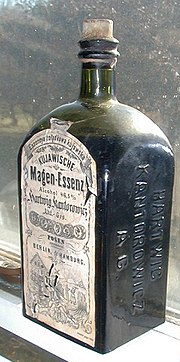
A bitters (plural also bitters) is traditionally an alcoholic preparation flavored with botanical matter for a bitter or bittersweet flavor. Originally, numerous longstanding brands of bitters were developed as patent medicines, but now are sold as digestifs, sometimes with herbal properties, and as cocktail flavorings.
Since cocktails often contain sour and sweet flavors, bitters are used to engage another primary taste and thereby balance out the drink and make it more complex, giving it a more complete flavor profile. (Full article...)
Selected ingredient 16
Portal:Drink/Selected ingredient/16

Purified water is water that has been mechanically filtered or processed to remove impurities and make it suitable for use. Distilled water was, formerly, the most common form of purified water, but, in recent years, water is more frequently purified by other processes including capacitive deionization, reverse osmosis, carbon filtering, microfiltration, ultrafiltration, ultraviolet oxidation, or electrodeionization. Combinations of a number of these processes have come into use to produce ultrapure water of such high purity that its trace contaminants are measured in parts per billion (ppb) or parts per trillion (ppt).
Purified water has many uses, largely in the production of medications, in science and engineering laboratories and industries, and is produced in a range of purities. It is also used in the commercial beverage industry as the primary ingredient of any given trademarked bottling formula, in order to maintain product consistency. It can be produced on-site for immediate use or purchased in containers. Purified water in colloquial English can also refer to water that has been treated ("rendered potable") to neutralize, but not necessarily remove contaminants considered harmful to humans or animals. (Full article...)
Selected ingredient 17
Portal:Drink/Selected ingredient/17

Citric acid is an organic compound with the chemical formula HOC(CO2H)(CH2CO2H)2. It is a colorless weak organic acid. It occurs naturally in citrus fruits. In biochemistry, it is an intermediate in the citric acid cycle, which occurs in the metabolism of all aerobic organisms.
More than two million tons of citric acid are manufactured every year. It is used widely as an acidifier, as a flavoring, and a chelating agent.
A citrate is a derivative of citric acid; that is, the salts, esters, and the polyatomic anion found in solutions and salts of citric acid. An example of the former, a salt is trisodium citrate; an ester is triethyl citrate. When citrate trianion is part of a salt, the formula of the citrate trianion is written as C6H
5O3−
7 or C
3H
5O(COO)3−
3.
Selected ingredient 18
Portal:Drink/Selected ingredient/18

Carrageenans or carrageenins (/ˌkærəˈɡiːnənz/ KARR-ə-GHEE-nənz; from Irish carraigín 'little rock') are a family of natural linear sulfated polysaccharides that are extracted from red edible seaweeds. Carrageenans are widely used in the food industry, for their gelling, thickening, and stabilizing properties. Their main application is in dairy and meat products, due to their strong binding to food proteins. In recent years, carrageenans have emerged as a promising candidate in tissue engineering and regenerative medicine applications as they resemble native glycosaminoglycans (GAGs). They have been mainly used for tissue engineering, wound coverage, and drug delivery.
Carrageenans contain 15–40% ester-sulfate content, which makes them anionic polysaccharides. They can be mainly categorized into three different classes based on their sulfate content. Kappa-carrageenan has one sulfate group per disaccharide, iota-carrageenan has two, and lambda-carrageenan has three.
A common red seaweed used for manufacturing the hydrophilic colloids to produce carrageenan is Chondrus crispus (Irish moss), which is a dark red parsley-like alga that grows attached to rocks. Gelatinous extracts of the Chondrus crispus seaweed have been used as food additives since approximately the fifteenth century. Carrageenan is a vegetarian and vegan alternative to gelatin in some applications, so may be used to replace gelatin in confectionery and other food. There is no clinical evidence for carrageenan as an unsafe food ingredient, mainly because its fate after digestion is inadequately determined.
The first industrial scale commercial cultivation of Eucheuma and Kappaphycus spp. for carrageenan was developed in the Philippines. The global top producers of carrageenan are the Philippines and Indonesia. Carrageenan, along with agar, are used to produce traditional jelly desserts in the Philippines called gulaman. (Full article...)Selected ingredient 19
Selected ingredient 20
Selected ingredient 21
Selected ingredient 22
Selected ingredient 23
Selected ingredient 24
Selected ingredient 25
Purge server cache


